
ASRM müllerian anomalies classification 2021
Download a PDF of this documentThere are many proposed classification systems for müllerian anomalies. The American Fertility Society (AFS) Classification from 1988 has been the most recognized and utilized. The advantages of this iconic classification include its simplicity, recognizability, and correlation with clinical pregnancy outcomes. However, the AFS classification has been criticized for its focus primarily on uterine anomalies, with exclusion of those of the vagina and cervix, its lack of clear diagnostic criteria, and its inability to classify complex aberrations. Despite this classification and others, the wide range of müllerian anomalies is still largely unknown and confusing to many providers. Consequently, müllerian anomalies may go undiagnosed for extended periods, receive inappropriate or inadequate surgical interventions, and result in persistent issues such as pain or loss of reproductive function. The American Society for Reproductive Medicine Task Force on Müllerian Anomalies Classification was formed and charged with designing a new classification. The Task Force set goals for a new classification and chose to base it on the iconic AFS classification from 1988 because of its simplicity and recognizability, while expanding and updating it to include all categories of anomalies. In addition, this was recognized as an opportunity to raise awareness of this area of medicine, educate providers and learners, and promote patient advocacy. Presented here is the new American Society for Reproductive Medicine Müllerian Anomalies Classification 2021. (Fertil Steril® 2021;116:1238-52. ©2021 by American Society for Reproductive Medicine.)
BACKGROUND
Müllerian anomalies are rare developmental anomalies of the female reproductive tract. There are many proposed classification systems for müllerian anomalies, and the American Fertility Society (AFS) Classification from 1988 has been the most recognized and utilized (1). This classification was based on the one introduced by Buttram and Gibbons in 1979 (2), which placed uterine anomalies into similar groups based on ‘‘failure of normal development,’’ resulting in groups with similar clinical manifestations, treatments, and pregnancy outcomes. In the AFS classification, anomalies are represented as simple drawings within each group. The advantages of this iconic classification include its simplicity, recognizability, and correlation with clinical pregnancy outcomes. However, the AFS classification has been criticized for its focus primarily on uterine anomalies, with exclusion of those of the vagina and cervix, its lack of clear diagnostic criteria, and its inability to classify complex aberrations.Since then, other classifications have been developed. Oppelt proposed the VCUAM classification (Vagina, Cervix, Uterus, Adnexa, and associated Malformations), whose goal was to describe the müllerian and associated anomalies accurately and precisely (3). Acién and Acién proposed their classification categorizing müllerian anomalies according to embryologic origin (4), and the European Society of Human Reproduction (ESHRE) and Embryology-European Society for Gynaecological Endoscopy (ESGE) developed a classification based primarily on uterine anatomy, with cervical and vaginal anomalies classified as independent supplementary subclasses to precisely identify each anomaly (5). In addition, specific measurement criteria using three-dimensional ultrasound are used to define septate and bicornuate uterus (5).
Despite the numerous classifications the wide range of müllerian anomalies is still largely unknown and confusing, not only to obstetrician-gynecologists and the respective subspecialists, but also to providers including radiologists, pediatricians, specialists in adolescent and emergency medicine, and pediatric general and urologic surgeons, who may encounter patients with these anomalies. This is primarily due to the relative rarity of müllerian anomalies and the limited exposure of these providers to patients with a müllerian anomaly during training or practice. Consequently, individuals may endure a delay in diagnosis for weeks, months, and even years; may undergo inappropriate or inadequate surgical intervention(s); and may have persistent issues including chronic pain and/or loss of reproductive function as a result.
DEVELOPMENT
A need for a new classification was apparent, and the ASRM Task Force on Müllerian Anomaly Classification was formed and charged with updating the AFS classification. The Task Force consisted of members of the ASRM and the Society of Reproductive Surgeons with expertise in the diagnosis and treatment of müllerian anomalies (Attaran, Lindheim, Petrozza, Pfeifer, and Rackow). Because these anomalies are often identified in adolescents, a designated representative from the North American Society of Pediatric and Adolescent Gynecology (NASPAG) (Zuckerman) was added to complement other Task Force members who were joint members of ASRM and NASPAG (Attaran, Pfeifer, and Rackow). The Task Force also included radiologists with expertise in body imaging and diagnosis of müllerian anomalies (Siegelman, Troiano, and Winter). ASRM staff with expertise in education (Goldstein) and curriculum design (Ramaiah) were also key members of the Task Force. Members of the Task Force met on a regular basis monthly to weekly for development, design, and input of data into the tool, assessing functionality and incorporating feedback.The Task Force was given free rein to design a new classification. To prepare, all existing classifications were reviewed, and each was assessed for its advantages and disadvantages. It was determined that an ideal classification should improve identification of müllerian anomalies, enhance communication between providers and researchers, and ultimately improve clinical care. The Task Force then identified the following goals to guide the development of a new classification:
1. Build on the Strengths of the 1988 American Fertility Society classification
The Task Force wanted the new ASRM classification to be simple, understandable, and recognizable. After much thought and discussion, the Task Force decided to modify and build on the old classification rather than create a completely new model. The AFS classification has the advantage of being simple, since it is based on clear drawings and is understandable, given the grouping of anomalies. It is also recognized as the gold standard and the most utilized. The Task Force focused on maintaining the simplicity of the 1988 AFS classification and capitalizing on its recognizability. In addition, the categories were modified to include three additional groups: longitudinal vaginal septum, transverse vaginal septum, and complex anomalies. Line drawings were maintained (although updated) as effective representation of the elements of the anomalies. While maintaining this understandable and recognizable format, the Task Force set the goal of expanding the utility of the new classification beyond a static reference into an educational tool, which as such would be ideally suited to an interactive format.2. Describe Anomalies Involving the Uterus, Cervix, and Vagina
The Task Force recognized that only some uterine anomalies and no cervical and vaginal anomalies were captured in the old classification. A goal was set to expand the current classification to include the wide spectrum of uterine anomalies and to also include cervical and vaginal anomalies. It was recognized that the spectrum of müllerian anomalies represents a continuum involving many separate, yet interrelated, elements. Thus, a single classification cannot neatly and effectively categorize anomalies into a single group; there was need for overlap between categories. In addition, the currently recognized anomalies do not reflect all possible müllerian abnormalities; undoubtedly, there remain more variations of anomalies yet to be discovered. Therefore, the classification should not be considered complete, but rather should acknowledge that complete classification is not possible and that there are combinations of anomalies that have yet to be seen or described. Therefore, the classification should be able to incorporate changes and additions over time.3. Standardize Terminology to Simplify Communication and Recognizability
The Task Force felt that the best way to communicate the essence of the anomalies was through descriptive words. For example, describing an anomaly to a colleague as ‘‘uterus didelphys, duplicated cervix, with obstructed right hemivagina and right renal agenesis’’ is easier to understand than terms utilizing the ESHRE-ESGE (U3 C2 V2) or VCUAM (V5a, C1, U2, A0, MR) classification systems. Recognizing that there is often more than one way to describe the same anomaly, the Task Force elected to list the most used terms but to specify the preferred term. In this way, consistency in terminology can be encouraged.In addition, defining anomalies such as septate and bicornuate uterus is an important function of any classification system. The group wanted to establish clear definitions of both of these anomalies and specify how they should be measured. Acknowledging that not all providers have access to all diagnostic modalities, the Task Force believed that the diagnosis should not be limited to one imaging or diagnostic modality.
Procedures to correct these anomalies are not recognized or incorporated into the Current Procedural Terminology coding system. Some of the surgeries to correct these anomalies require specific expertise, are often time consuming, and therefore should only be performed in conjunction with an experienced surgeon. By incorporating these options into the classification, the Task Force hoped to better define these treatments.
4. Identify in Scientific Databases
By standardizing the nomenclature, the new classification aimed to facilitate literature searches in the area of müllerian anomalies. Currently, there are identified search terms that are frequently used for anomalies; interestingly, they may differ between specialties. For example, double uterus, obstructed hemivagina, and ipsilateral renal agenesis; obstructed hemivagina, ipsilateral renal anomaly (OHVIRA); and HWW (Herlyn-Werner-Wonderlich) all refer to the same anomaly yet are not necessarily recognized as such. The group wanted to incorporate these terms into the classification to be inclusive, but by identifying preferred terms, to establish which terms should now be used. By using consistent, understandable vernacular, the Task Force hoped to facilitate communication, research, and the ability to search databases.5. Educate Providers on Presentation, Diagnosis, and Management
The new classification aims to educate providers and trainees across medical disciplines regarding the variety of anomalies and their presentation, diagnosis, and management. Categorizing the anomalies is not enough. Many anomalies present in a similar fashion, and there should be a way to point out which anomalies are similar in presentation but structurally different. Guidance on imaging modalities, with examples, should be incorporated to aid in diagnosis. In considering education regarding management, the Task Force recognized the importance of both medical and surgical options. Surgical management may differ not only between categories of anomaly but also between individual variants within an anomaly. The inverse is also true: surgical management may be similar for anomalies from different categories that have similar appearance. Thus, an important goal of this classification is to educate the user about both medical and surgical options available for each anomaly, thereby improving clinical outcomes.An interactive electronic format ideally facilitates comparisons between anomalies and education regarding their differences and similarities. In addition, the interactive format can easily be incorporated into educational modules for students, trainees, and providers alike across specialties. In this way, the Task Force hopes to improve overall patient care through education and access.
6. Use by Providers Across Disciplines
Patients with müllerian anomalies are cared for not only by gynecologists, but also by providers in adolescent medicine, pediatrics, radiology, and pediatric urology and surgery. Because most classification systems are published in the gynecologic literature, they may be less likely to be viewed by providers in other fields. With the use of an interactive format, the classification can be accessed to the desired depth by any student learner or provider anywhere at any time and can be utilized to educate all on the presentation, diagnosis, and management options.7. Raise Awareness of the Range of Variations
The AFS classification depicts a small sample of müllerian anomalies, and therefore many providers are unfamiliar with the full spectrum of anomalies. For example, uterus didelphys and complete septate uterus are sometimes assumed to be the same, and some practitioners are unaware that complete septate uterus exists, since it is not depicted in the AFS 1988 classification. The Task Force recognized that raising awareness of the multiple variations that exist is important because treatment options vary. The new classification should incorporate the many variations of known anomalies, while raising awareness that more are likely to be identified in the future. An accessible interactive format will allow for future expansion, greater exposure, and more educational options to achieve these goals.8. Promote Patient Awareness and Support Advocacy
There is a need for patient education and advocacy, since some patients with a müllerian anomaly have suffered a significant delay in diagnosis or definitive treatment, and many patients and their supporters want to be better educated about their condition. The updated classification system should be inclusive and educational. Because this multifaceted format is ideal for patient education and interactive learning, patient advocacy can be promoted.9. Incorporate Associated Anomalies
The Task Force wanted to incorporate the incidence of anomalies associated with nonsyndromic müllerian anomalies into the classification system. A MEDLINE search of English publications from 1949 was performed in 2018 and updated in 2020. In total, 2,499 articles, comprising 1,607 on müllerian anomalies and 892 on müllerian anomalies and associated malformations, were reviewed by a sub-Task Force, and pertinent articles were identified. Overall, the quality of the literature was poor, as it was composed primarily of case reports and small case series. It is difficult to determine the incidence of associated anomalies from the literature, for several reasons. There is a high degree of bias because of the rarity of müllerian anomalies and the quality of the literature. Very few studies evaluated the presence of associated anomalies in nonsyndromic müllerian anomalies. Minimally invasive imaging techniques were not available at the time many studies were published, making diagnosis of associated anomalies less reliable. However, clear associations were noted. Renal anomalies were associated with müllerian agenesis, with a variable incidence that might approach 40% (6–9). In addition, unilateral obstructed anomalies, such as obstructed hemivagina and uterine remnant, were highly correlated with ipsilateral renal agenesis or anomaly. In the case of obstructed hemivagina, the incidence of ipsilateral renal agenesis or anomaly was as high as 95% (10–12). Thus, renal imaging is strongly recommended in the presence of müllerian agenesis and unilateral obstructed vaginal and uterine anomalies. The data were not sufficient to determine the incidence of renal abnormalities seen in conjunction with other müllerian anomalies.CLASSIFICATION
The ASRM Müllerian Anomalies classification 2021 (MAC2021) classifies müllerian anomalies into the nine categories below. Because müllerian anomalies represent a continuum of development and many have combined elements, some anomalies appear in more than one category. This is particularly true for the vaginal anomalies, since they are often seen in combination with uterine and cervical anomalies. Depending on how the anomaly presents, the provider may perceive the anomaly as primarily vaginal or uterine; this classification allows for this flexibility. For anomalies that are hard to classify or for which there is disagreement about in which category they belong, the classification allows cross-referencing and comparison between categories to help determine diagnosis and treatment options, since many will be similar. For example, it is possible to differentiate a unicornuate uterus with blind remnant from a didelphys uterus with a hemiuterus with an atrophic cervix. In addition, each anomaly can be described by specific anatomic terms that reflect the findings, which should eliminate confusion.The collection of anomalies we have included is not meant to represent all known anomalies. Given the developmental process and the unlimited number of possible variations, we aimed to include most of the anomalies that have been described. In addition, we alerted the user to all potential variations that could be seen (in the VARIANTS section). For those who have cared for patients with a müllerian anomaly, it is clear that one has to expect the unexpected, and many experienced providers are still seeing novel anomalies. The ASRM MAC2021 classification can be updated to reflect new anomalies and information moving forward.
Because the Task Force wanted to maintain simplicity, the main classification page reflects a representative sampling of anomalies within each category. Users can expand each category to see all the variants depicted in each section. When the anomaly is one-sided, users may hover over it to see the picture and description represented as a right- or left-sided anomaly. A printable version of the main classification, similar to the AFS 1988 classification, is available for those without access to the interactive format (Fig. 1). Unlike the AFS classification, anomaly categories are no longer numbered but instead are identified by descriptive terminology:
- Müllerian agenesis
- Cervical agenesis
- Unicornuate uterus
- Uterus didelphys
- Bicornuate uterus
- Septate uterus
- Longitudinal vaginal septum
- Transverse vaginal septum
- Complex anomalies
IMPORTANT FEATURES OF ASRM MÜLLERIAN ANOMALIES CLASSIFICATION 2021
The main classification page shows a few representative anomalies for each category (Fig. 2). Each can be expanded to show all included anomalies in each category (Fig. 3A and B). Where indicated, right and left sidedness is noted. The user may hover over the image to visualize right and left sidedness. A static printable version is available to download that depicts right- or left-sided options as ‘‘R/L’’ (Fig. 1). Educational Elements for Each Anomaly
Each category has five educational elements, as shown on the main educational elements page (Fig. 4). These are intended to be used as a reference for potential anomalies in each category, for general information and learning about each category and anomalies within, and for considering which anomaly a patient has and what diagnostic and treatment options to consider.VARIANTS subpages show drawings that depict the potential variations for each anomaly within the category (Fig. 5). For each anomaly depicted, the possible variations for the uterine, cervical, and vaginal portions are noted. This highlights the scope of possible anomalies to enhance the knowledge of the user. The KNOWN AS section for each variant lists known names or synonyms, with the preferred terminology identified by underlining.
SIMILAR TO subpages show other anomalies that are similar in presentation, examination, and imaging to help providers refine their differential diagnosis and arrive at the correct diagnosis (Fig. 6). By clicking on any anomaly listed in the ‘‘similar to’’ section, the user will be brought to the main page for that similar anomaly to explore presentation, imaging, and treatment for comparison
PRESENTATION subpages include clinical information for each category of anomaly (Fig. 7). The goal is to educate the user on typical presentations and other similar anomalies that may present in the same way. The subpage has three sections:
- Symptoms indicates age at onset and typical symptoms attributed to the disorder.
- Examination lists key examination findings of the anomaly.
- Differential lists other possible differential diagnoses for conditions with similar presentation. The user may choose any of those to be brought to the pertinent section for review and cross reference.
IMAGING subpages describe the best screening tool, diagnostic strategy, and findings for an anomaly category and include examples of pertinent selected anomalies in three imaging modalities: magnetic resonance imaging (MRI), ultrasound, and hysterosalpingogram. For some anomalies, there will not be examples of each imaging technique (Fig. 8). This section educates the user on the available imaging modalities to confirm the correct diagnosis before proceeding with surgery. For example, MRI images of müllerian agenesis and normal pelvis may be viewed in the tool (Fig. 9).
Specific diagnostic elements are included for septate, arcuate, normal, and bicornuate uterus. The Task Force modified the septate uterus diagnostic criteria from the ASRM guideline in 2016 (13). The Task Force specified that septate uterus should be defined as having an endometrial septum length of >1 cm as measured from the bicornual line with the leading edge of the septum having an angle of <90° (Fig. 10). This definition was based on data correlating outcome data with size (14). Understanding that not all providers have access to the same imaging modality, we speciffically state that the size of the septum may be assessed by any technique (two-dimensional ultrasound, three-dimensional ultrasound, MRI, sonohysterogram, hysteroscopy [combined with imaging of external contour of uterus], or combined hysteroscopy-laparoscopy). The arcuate uterus is defined as having an endometrial indentation length of ≥1.0 cm, with a normal uterus defined as having no indentation (Fig. 10). This reflects the clinically insignificant status of an arcuate uterus (14). In a similar fashion, we have defined the bicornuate uterus as having an external fundal indentation of >1.0 cm (Fig. 10), which does not represent a change from 2016 (13).
Figure 1. Printable version of the Mullerian Anomalies Classification Table.


Figure 2. Portion of main classification page showing the first four anomalies.
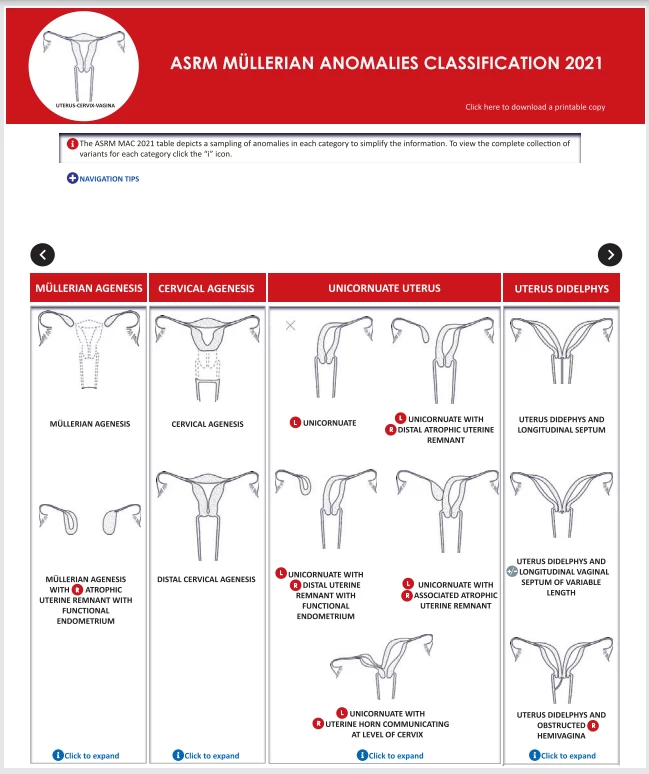
Figure 3. An example of how the American Society of Reproductive Medicine Müllerian Anomalies Classification 2021 (MAC2021) shows a representative sample of the anomalies.
By clicking on ‘‘Click to expand,’’ the expanded collection of depicted anomalies may be seen. Here the müllerian agenesis category can be seen as (A) the MAC2021 and (B) the expanded view. Note that for some anomalies there may be many more images in the expanded view.

Figure 4. The educational elements page.
Each category has its own page. Depicted here is the mullerian agenesis page. Note the icons depicting the € five educational elements.
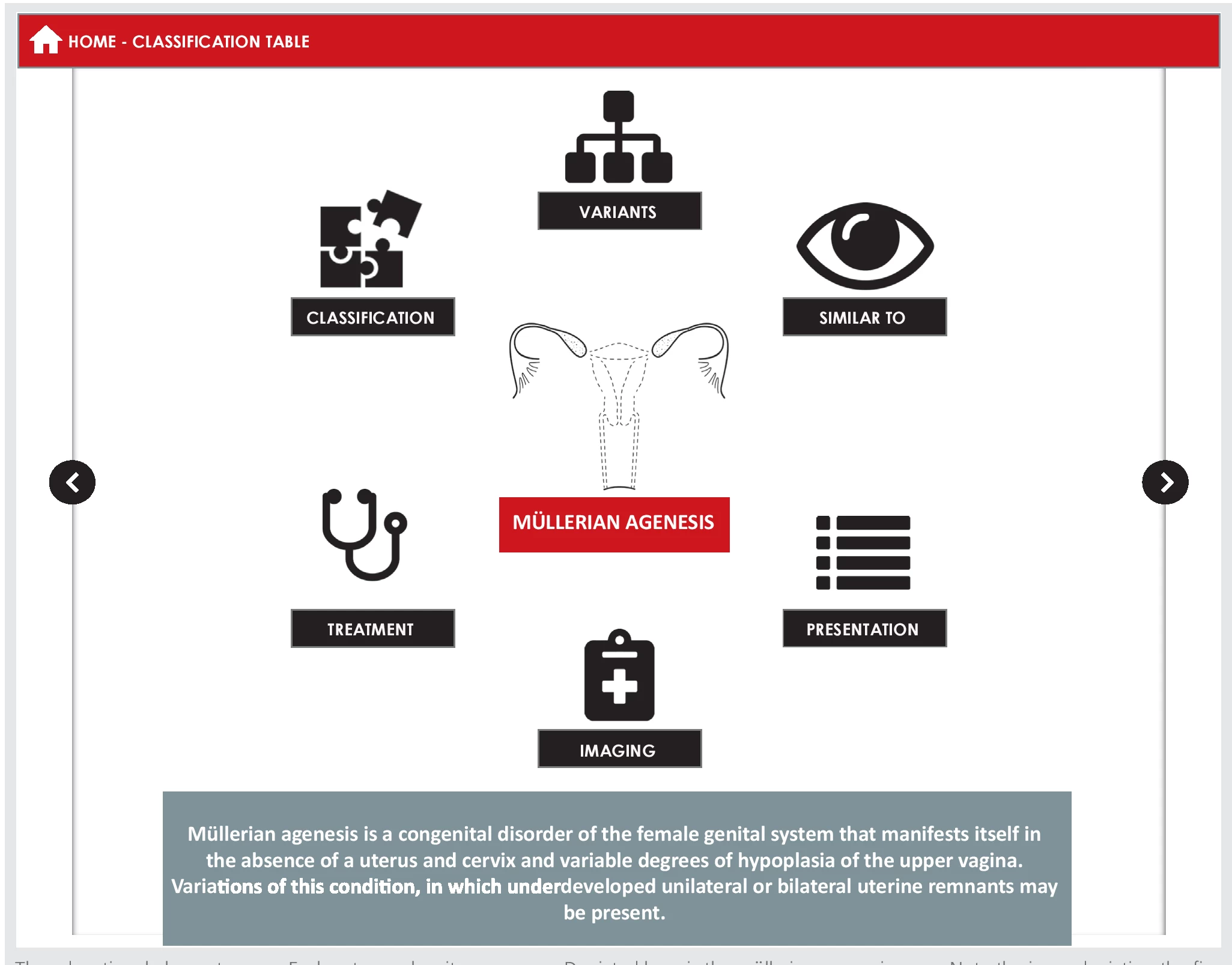
- Medical—options to suppress menstruation to treat pain
- Dilation—indications for nonsurgical vaginal lengthening procedures
- Surgical—surgical approaches to correct each anomaly, including links to pertinent surgical videos
Figure 5. VARIANTS section for müllerian agenesis.
Depicts possible variants for the uterus, cervix, and vagina. The KNOWN AS box shows all recognized names for the specific anomaly, with the preferred term underlined.
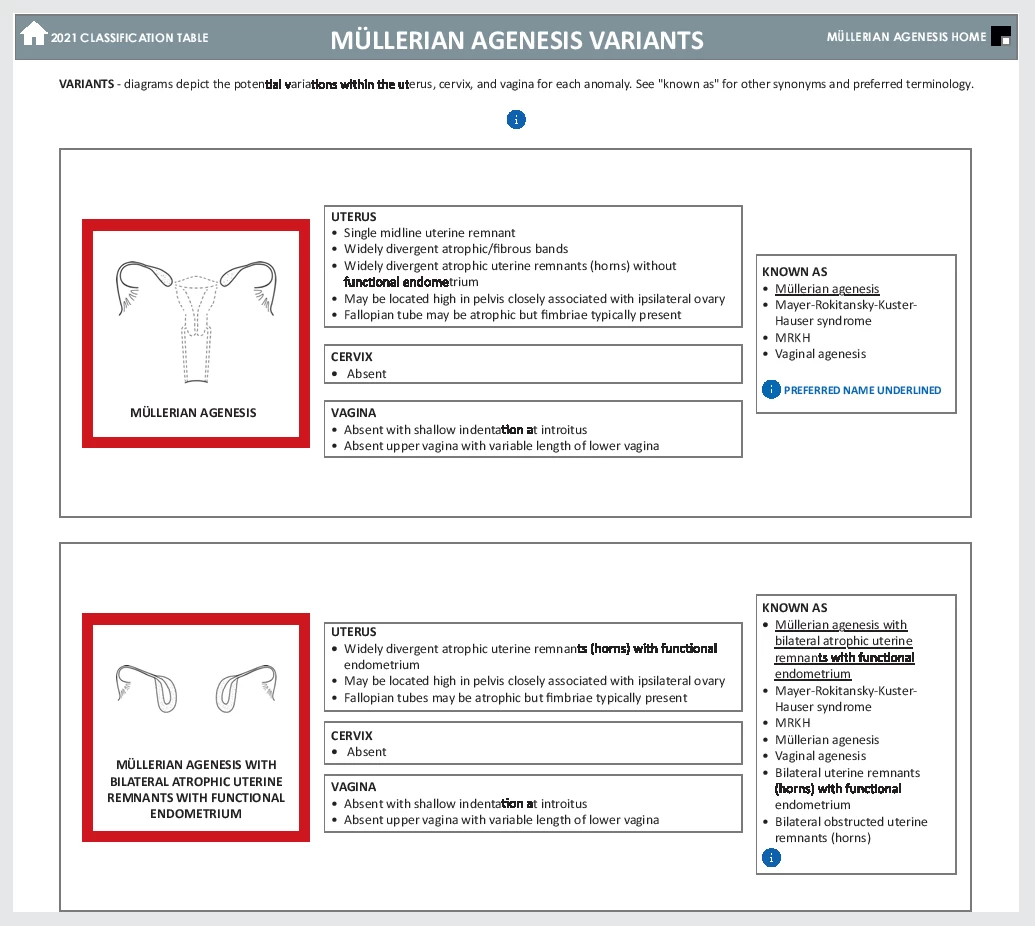
Figure 6. SIMILAR TO subpage for müllerian agenesis shows other anomalies that have similar presentation, imaging, and treatment.

Figure 7. PRESENTATION subpage for müllerian agenesis.
Depicts symptoms, examination, and differential diagnosis.
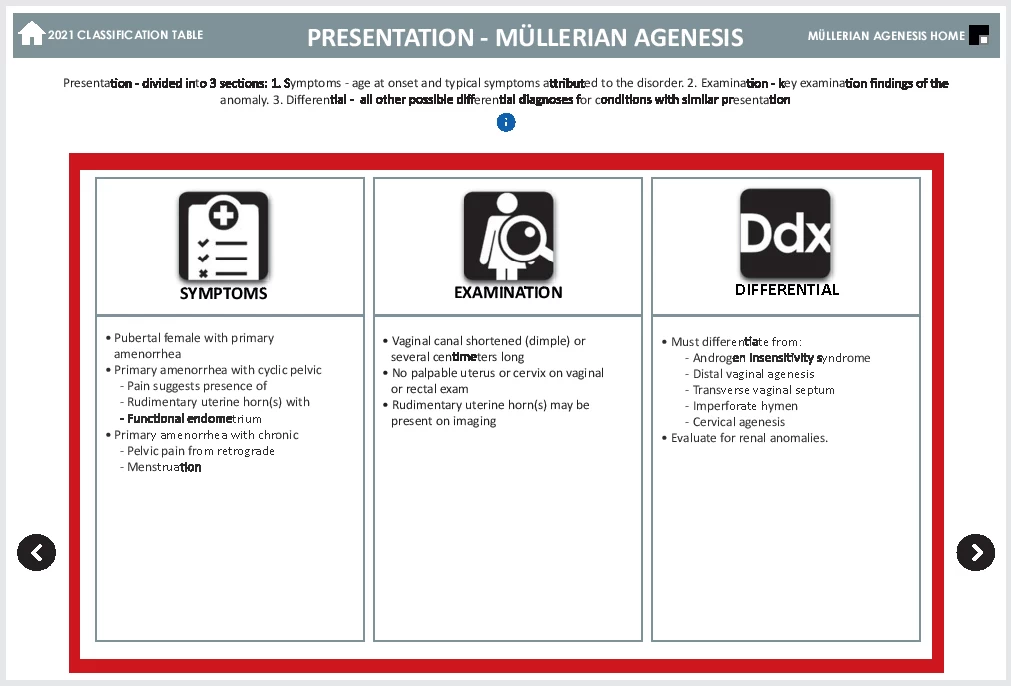
VALIDATION
The ASRM MAC2021 was shown to groups of individuals for feedback regarding content, usability, flow, and educational merit. These groups included members of ASRM who had no special expertise in this area, trainees in obstetrics-gynecology and reproductive endocrinology and infertility, medical students, and the ASRM Practice Committee and ASRM Board, both of which consist of representatives from across different disciplines and areas of expertise within reproductive medicine. Feedback was also solicited from members of the lay public on usability, visual appearance, and elements of interactivity.DESIGN AND TECHNOLOGY
The goal for the development of the ASRM MAC2021 web application prototype was to provide a high fidelity and fully interactive tool. Preliminary discussions, project specification, and outline of high-level sections with the Task Force chair were followed by discussion with the larger Task Force members. Initial analysis showed the development process to be a complex combination of educational content interlinked with technology for interactive delivery and user experience. Two parallel processes were initiated.Educational design was guided by the successive approximation model (15) and coordinated by the education content expert (Goldstein). Technology design and development were guided by the agile model for software development (16) and developed by the curriculum design strategist (Ramaiah). Multiple agile sprints were deployed with targeted iterations from user feedback (Practice Committee, ASRM Board, and trainees) with smaller sprints at each increment. The principals (Pfeifer and Ramaiah) met weekly to review the sprints, followed by biweekly reviews by the Task Force members. The primary and large groups met via teleconference and email to view, review, and share feedback.
The primary use cases were designed to allow users to navigate across the main classification table (home icon) and the main educational elements for each anomaly (grid icon). The complex anomaly section was redesigned to be a sub-use case to accommodate the flow of the educational content that was unique to this category. The ASRM MAC2021 tool is primarily designed to be navigated as two use cases with multiple pathways within and between screens: linear interaction and nonlinear, self-directed interaction. The linear interaction allows a user to transition from one screen to the next in a linear path within an anomaly using the educational elements as a guide from the central anomaly. The self-directed interaction allows a user to navigate across and between anomalies and educational elements according to a selected direction (see the Appendix).
The ASRM MAC2021 tool was designed in Adobe XD software (v 43.0.12) and is hosted on the ASRM website. The tool is optimized to landscape layout for visualization and ease of navigation. It is best accessed through a laptop or personal computer and is functional when accessed through an Apple iPad. Each primary anomaly has five major educational elements branching to 80+ images of variants and 100+ images of MRI, ultrasound, and hysterosalpingogram. The tool includes 81 screens of interface items with visual elements, hover features, and colors for high fidelity and an interactive user experience.
Figure 8. IMAGING section shows best screening tool, diagnostic strategy, and typical findings.
Clicking on the MRI icon opens pictures of pertinent images and comparative normal images for educational purposes and to help comparative diagnosis.
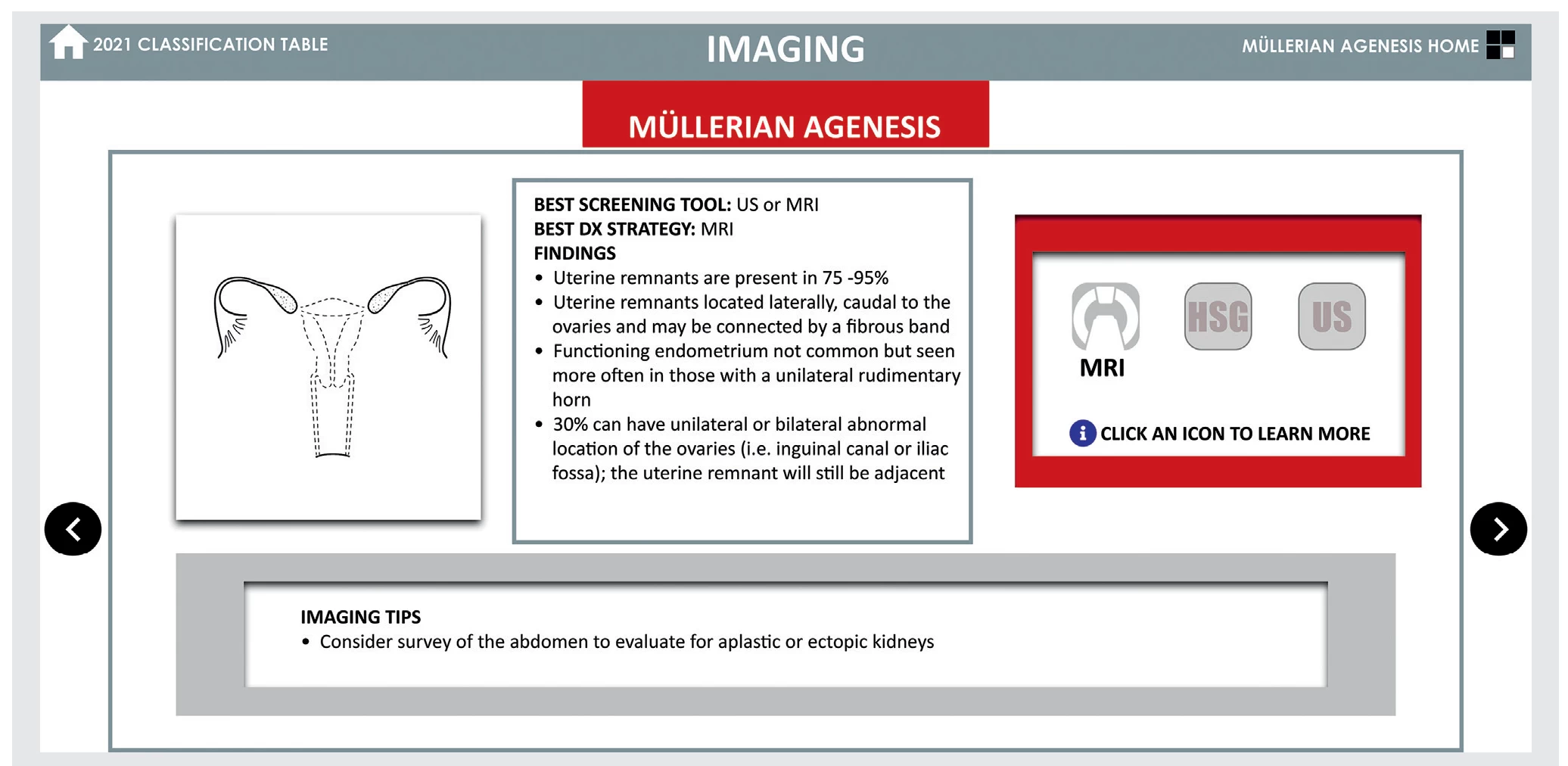
FLOW
The tool is designed with three main levels, moving from general to specific: the anomaly category classification (overview), the educational elements level (branching to choose information of various types), and the anomaly-specific information level. Users can navigate within an anomaly for detailed information in that anomaly (linear) or between anomalies to compare like information across different anomalies (self-directed) (Fig. 12).HOW TO USE THE TOOL
The tool may be used in several ways:- To categorize müllerian anomalies in a simple and clear way using diagrams and descriptive terminology.
- As a reference for preferred nomenclature.
- As an educational reference to study müllerian anomalies and correlate presentation, imaging, and treatment (linear flow, Fig. 12).
- As an educational tool to compare and contrast anomalies with one another (self-directed flow, Fig. 12).
- As a reference to aid in the diagnosis and treatment of a patient presenting with symptoms suggestive of a müllerian anomaly. The user may compare presentation and diagnostic imaging between possible anomalies to aid in establishing the correct diagnosis and formulating a treatment plan (see the Appendix).
Figure 9. Magnetic resonance image of müllerian agenesis with adjacent image of a normal uterus for comparison.
In the imaging section there are multiple examples of individual anomalies.
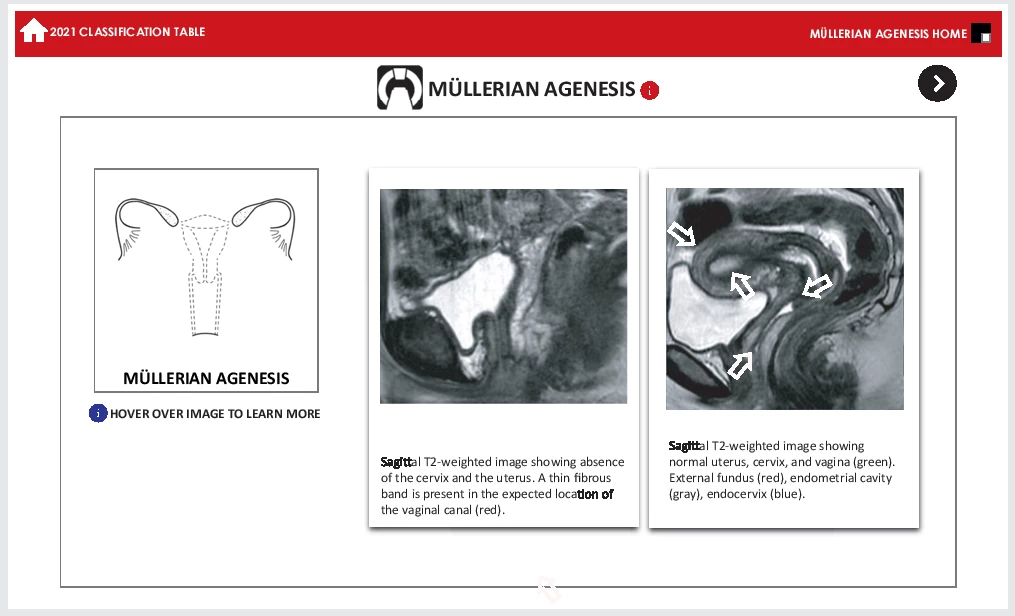
Figure 10. Diagnostic criteria for partial septate uterus.
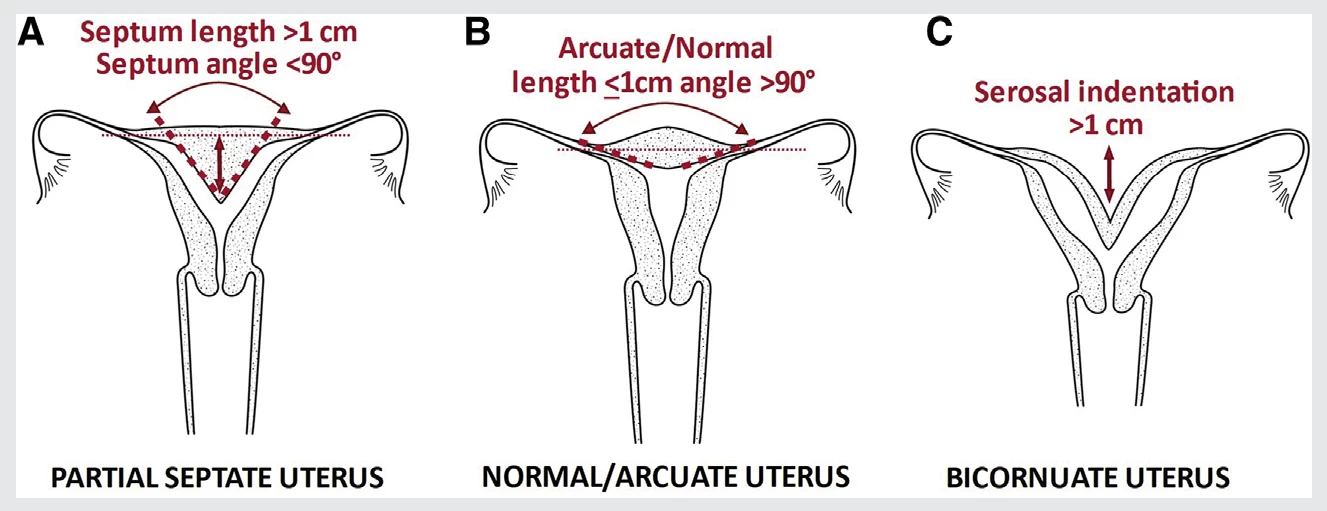
CONCLUSION
There are many proposed classifications for müllerian anomalies, and each has advantages and disadvantages. However, the wide range of müllerian anomalies remains confusing for the broad spectrum of health care providers who may identify or need to evaluate such patients. An ideal classification would enable the identification of müllerian anomalies, enhance communication between providers and researchers, and ultimately improve clinical care. When charged with designing a new classification, the ASRM Task Force on Müllerian Anomalies Classification decided to update the AFS 1988 classification because of its simplicity and recognizability rather than create a new system. The goals of this update were to identify and categorize anomalies; standardize terminology; facilitate communication and searchability in scientific databases; educate providers on clinical presentation, diagnosis, and management; raise awareness of the range and variety of anomalies; and promote patient awareness and advocacy. The updated ASRM MAC2021 relies on simple diagrams and descriptive terminology to identify anomalies of uterine, cervical, and vaginal origin. Müllerian anomalies are categorized into distinct groups. However, because they represent a continuum of developmental variation, some anomalies may be in more than one group, In addition, the classification has an interactive educational component encompassing presentation, diagnosis, and management of müllerian anomalies, with several learning options. It is hoped that the ASRM MAC2021 classification will provide a better opportunity to recognize and appreciate the multiple variations of anomalies and engage a broader audience of students and providers who may care for these patients.Figure 11. Diagnostic criteria for arcuate uterus.
The American Society of Reproductive Medicine Müllerian Anomalies Classification 2021 (MAC2021) has combined arcuate and normal uterus, reflecting the clinical relevance of arcuate uterus.

Figure 12. Diagnostic criteria for bicornuate uterus.

The ASRM Task Force on Müllerian Anomalies Classification acknowledges with deep appreciation the contributions of Richard Reindollar, M.D., for championing this endeavor. The Task Force also gratefully acknowledges the contributions of the Practice Committee of the Society of Reproductive Surgeons: Rony Elias, M.D., Stephanie Estes, M.D., Rebecca Flyckt, M.D., Linnea Goodman, M.D., Ranjith Ramasamy, M.D., and Divya Shah, M.D., M.M.E., as well as contributions by Pietro Bortoletto, M.D., Phillip Romanski, M.D., Nina Vyas, M.D., Taylor Sorenson, Julie Beckham, Larry Riley, and Dani Mosley. All Task Force members disclosed commercial and financial relationships with manufacturers or distributors of goods or services used to treat patients.
REFERENCES
- American Fertility Society. Classification of adnexal adhesions, distal tubal occlusion, tubal occlusion secondary to tubal ligation, tubal pregnancies, mullerian anomalies, and intrauterine adhesions. Fertil Steril 1988;49: 944–55.
- Buttram VC Jr, Gibbons WE. Mullerian anomalies: a proposed classification. (An analysis of 144 cases). Fertil Steril 1979;32:40–6.
- Oppelt P, Renner SP, Brucker S, Strissel PL, Strick R, Oppelt PG, et al. The VCUAM (Vagina Cervix Uterus Adnex–associated Malformation) classification: a new classification for genital malformations. Fertil Steril 2005;84: 1493–7.
- Acien P, Acien MI. The history of female genital tract malformation classifications and proposal of an updated system. Hum Reprod Update 2011;17: 693–705.
- Grimbizis GF, Gordts S, Di Spiezio Sardo A, Brucker S, De Angelis C, et al. The ESHRE/ESGE consensus on the classification of female genital tract congenital anomalies. Hum Reprod 2013;28:2032–44.
- Chen N, Pan H, Luo G, Wang P, Xie Z, Hua K, et al. Clinical characteristics of 1,055 Chinese patients with Mayer-Rokitansky-Ku€ster-Hauser syndrome: a nationwide multicentric study. Fertil Steril 2021;116:558–65.
- Kapczuk K, Iwaniec K, Friebe Z, Kędzia W. Congenital malformations and other comorbidities in 125 women with Mayer-Rokitansky-Ku€ster-Hauser syndrome. Eur J Obstet Gynecol Reprod Biol 2016;207: 45–9.
- Lalatta F, Motta F, Restelli E, Bellini M, Miozzo M, Gervasini C, et al. Dysmorphologic assessment in 115 Mayer-Rokitansky-Ku€ster-Hauser patients. Clin Dysmorphol 2015;24:95–101.
- Oppelt PG, Lermann J, Strick R, Dittrich R, Strissel P, Rettig I, et al. Malformations in a cohort of 284 women with Mayer-Rokitansky-Ku€ster-Hauser syndrome (MRKH). Reprod Biol Endocrinol 2012;10:57.
- SmithNA,Laufer MR.Obstructed hemivagina and ipsilateral renal anomaly (OHVIRA) syndrome: management and follow-up. Fertil Steril 2007;87:918–22.
- Tong J, Zhu L, Lang J. Clinical characteristics of 70 patients with Herlyn-Werner-Wunderlich syndrome.Int JGynaecol Obstet 2013;121:173–5.
- Fedele L, Motta F, Frontino G, Restelli E, Bianchi S. Double uterus with obstructed hemivagina and ipsilateral renal agenesis: pelvic anatomic variants in 87 cases. Hum Reprod 2013;28:1580–3.
- Practice Committee of the American Society for Reproductive Medicine. Uterine septum: a guideline. Fertil Steril 2016;106:530–40.
- Fedele L, Bianchi S, Marchini M, Mezzopane R, Di Nola G, Rozzi L. Residual uterine septum of less than 1 cm after hysteroscopic metroplasty does not impair reproduction. Hum Reprod 1996;11:727–9.
- Allen M, Sites R. Leaving ADDIE for Sam: an agile model for the best learning experiences. Danvers, MA: ASTD Press; 2012.
- Ambler SW. Agile Software Development at Scale. In: Meyer B, Nawrocki JR, Walter B (eds) Balancing agility and formalism in software engineering. CEE-SET 2007. Lecture Notes in Computer Science, vol 5082. 2008 Springer, Berlin, Heidelberg.
Practice Documents
ASRM Practice Documents have been developed to assist physicians with clinical decisions regarding the care of their patients.
Evidence-based guideline: Premature Ovarian Insufficiency (2025)
This guideline on premature ovarian insufficiency (POI) offers best practice advice on the care of women with POI.
Gamete and embryo donation guidance (2024)
Explore the latest guidelines for evaluating sperm, oocyte, and embryo donors and recipients. Includes FDA, CDC, and ASRM standards for optimal safety and outcomes.
Maternal cardiovascular morbidity and mortality associated with pregnancy in individuals with Turner syndrome: a committee opinion (2024)
In individuals with Turner syndrome, the risk of death from aortic dissection or rupture during pregnancy may be as high as 1%.






